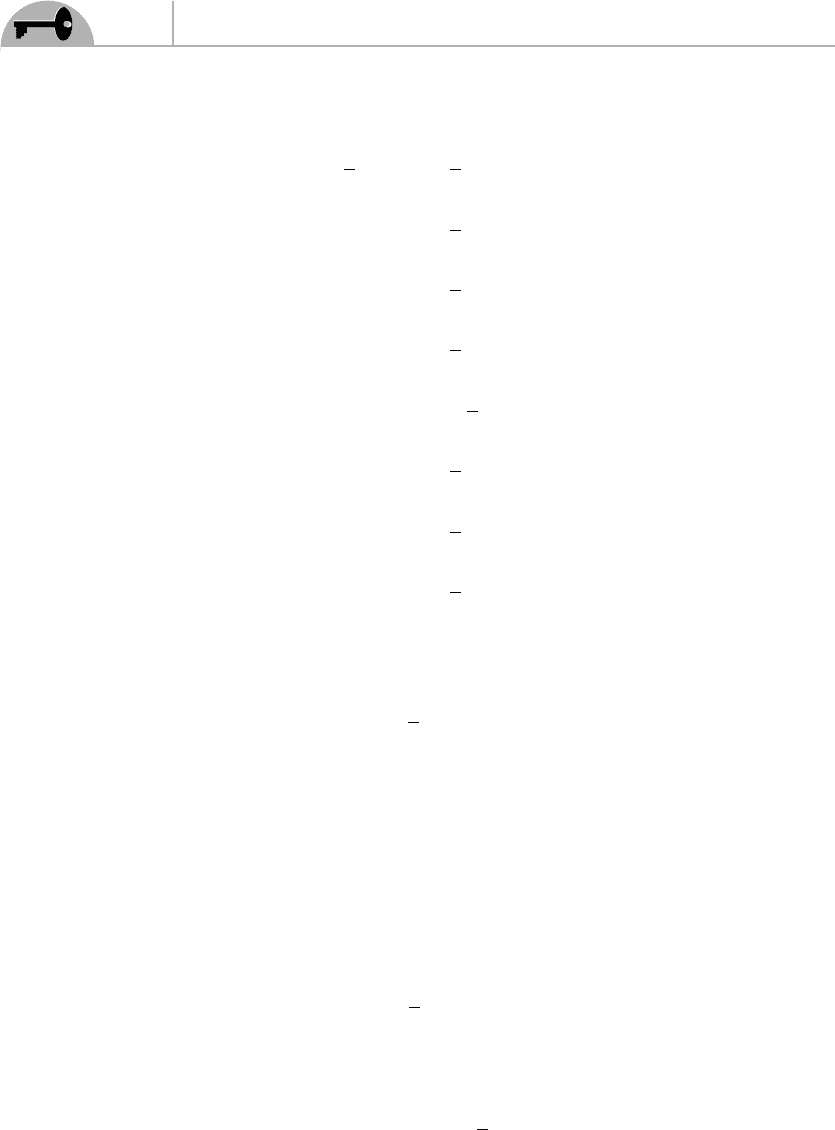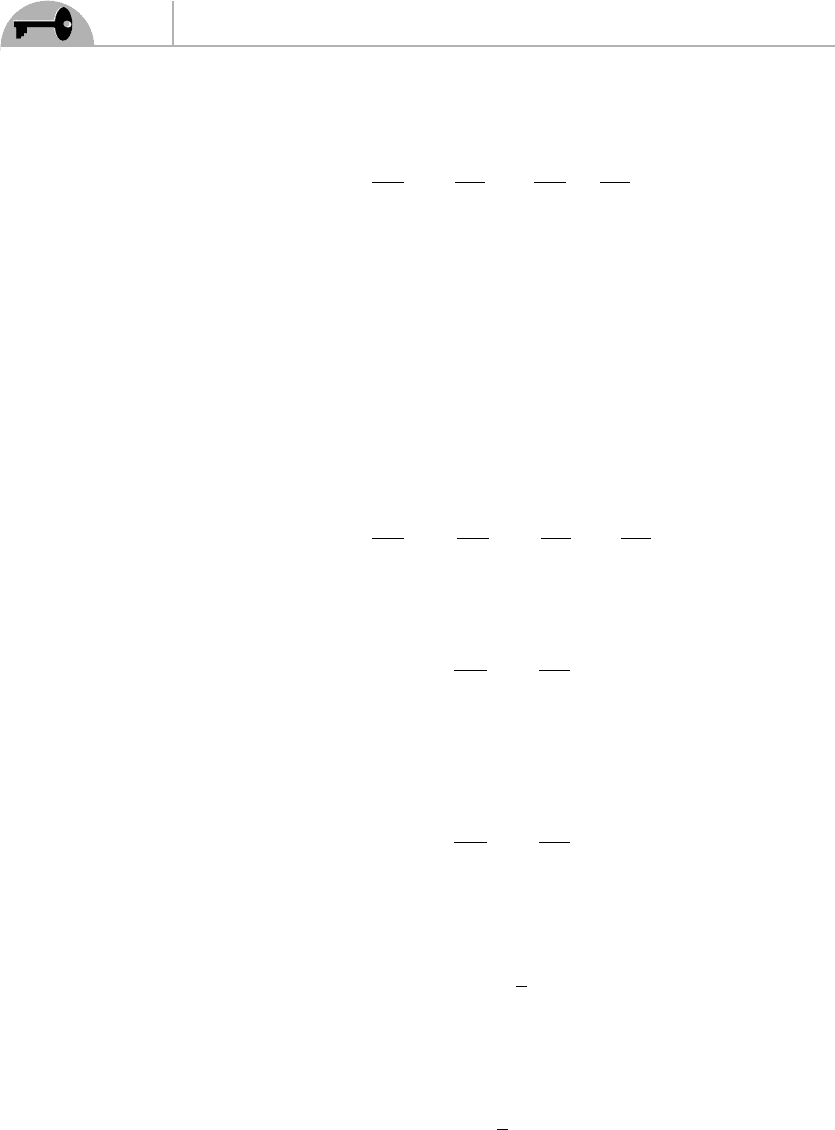Labelle P. Supersymmetry DeMYSTiFied
Подождите немного. Документ загружается.


446
Supersymmetry Demystified
Consider first the spin part:
1
2
ijk
σ
jk
=
i
8
ijk
(σ
j
¯σ
k
− σ
k
¯σ
j
)
=
i
8
ijk
(−σ
j
σ
k
+ σ
k
σ
j
)
=
i
8
ijk
(−σ
j
σ
k
+ σ
k
σ
j
)
=
i
8
ijk
[σ
k
,σ
j
]
=−
1
4
ijk
kja
σ
a
=
1
4
ijk
ajk
σ
a
=
1
2
δ
ia
σ
a
=
1
2
σ
i
which is simply the spin S
i
! Now consider the spatial part:
1
2
ijk
(x
j
p
k
− x
k
p
j
)
Since both the Levi-Civita symbol and the expression in parenthesis are anti-
symmetric in the indices j and k, we may write this as
ijk
x
j
p
k
which is of course the ith component of the total orbital angular momentum,
L
i
= (r ×p)
i
. Our final result is therefore
1
2
ijk
M
jk
= S
i
+ L
i
7.3 We have
W
0
|p
0
=
1
2
0ijk
M
jk
P
i
|p
0

APPENDIX B Solutions to Exercises
447
But the only P
i
that does not give zero when acting on this state is P
3
, which
is equal to −P
3
. Therefore,
W
0
|p
0
=−
1
2
03 jk
M
jk
P
3
|p
0
=−
1
2
03 jk
M
jk
E|p
0
=
1
2
3 jk
M
jk
E|p
0
= (S
z
+ L
z
)E|p
0
= Es
z
|p
0
(B.44)
where we have used Eq. (7.8) (we use the notation S
3
= S
z
and L
3
= L
z
).
Substituting this into Eq. (7.22) leads again to
h = s
z
=s ·
ˆ
p
7.4 Following the same steps as in Section 7.2 and using the second relation of
Eq. (6.86), we have
[
¯
Q
˙a
, W
0
] =
1
2
03ij
[
¯
Q
˙a
, M
ij
]P
3
=−
1
2
03ij
¯σ
ij
¯
QP
3
(B.45)
The only differences with what we did earlier is therefore,
¯
Q
˙a
and that we
simply get ¯σ
ij
instead of σ
ij
. However, from the definition of σ
μν
and ¯σ
μν
,it
is clear that when both indices are spatial, the two expressions are equal, i.e.,
¯σ
ij
= σ
ij
Indeed, σ
μν
and ¯σ
μν
differ only when one index is equal to 0 and the second
index is spatial.
Our final result is thus identical to Eqs. (7.28) and (7.29) except for the fact
that we have supercharges with upper dotted indices:
¯
Q
˙
1
, W
0
=−
1
2
¯
Q
˙
1
P
3
¯
Q
˙
2
, W
0
=
1
2
¯
Q
˙
2
P
3

448
Supersymmetry Demystified
For the commutator with the charges
¯
Q
˙a
, we could repeat the above steps using
the first relation of Eq. (6.86) or, more simply, use
¯
Q
˙
1
=
¯
Q
˙
2
and
¯
Q
˙
2
=−
¯
Q
˙
1
to get
¯
Q
˙
2
, W
0
=−
1
2
¯
Q
˙
2
P
3
¯
Q
˙
1
, W
0
=
1
2
¯
Q
˙
1
P
3
We can finally express this in terms of components with lower undotted indices
using
¯
Q
˙
1
= Q
†
1
and
¯
Q
˙
2
= Q
†
2
, which confirms Eq. (7.32).
7.5 The Majorana charge spinor is, as already shown in Eq. (7.43),
Q
M
=
⎛
⎜
⎜
⎜
⎜
⎜
⎜
⎝
Q
†
2
−Q
†
1
Q
1
Q
2
⎞
⎟
⎟
⎟
⎟
⎟
⎟
⎠
(B.46)
whereas
¯
Q
M
= (Q
M
)
†
γ
0
=
Q
†
1
, Q
†
2
, Q
2
, − Q
1
(B.47)
It is convenient to write γ
μ
as
γ
μ
=
⎛
⎝
0¯σ
μ
σ
μ
0
⎞
⎠
(B.48)
The anticommutator (7.44) then gives 16 relations. For example,
{Q
M1
,
¯
Q
M1
}=(γ
μ
)
11
P
μ
which, using Eqs. (B.46), (B.47), and (B.48), gives
{Q
†
2
, Q
†
1
}=0
Of the 16 anticommutators, 8 are equal to zero and reproduce Eqs. (6.70)
and (6.71). As an example of a nonzero anticommutator, set a = 3 and b = 1
to find
{Q
M3
,
¯
Q
M1
}={Q
1
, Q
†
1
}=(γ
μ
)
31
= (σ
μ
)
11
P
μ
(B.49)

APPENDIX B Solutions to Exercises
449
On the other hand, with a = 2 and b = 4, we find
{Q
M2
,
¯
Q
M4
}={−Q
†
1
, −Q
1
}={Q
†
1
, Q
1
}=( ¯σ
μ
)
22
P
μ
(B.50)
If we recall that ¯σ
0
= σ
0
= 1 and that ¯σ
i
=−σ
i
, it is easy to convince
ourselves that ( ¯σ
μ
)
11
= (σ
μ
)
22
, so we indeed find that both Eq. (B.49) and
Eq. (B.50) yield
{Q
1
, Q
†
1
}=(σ
μ
)
11
P
μ
Two of the other nonzero anticommutators are
{Q
M3
,
¯
Q
M2
}={Q
1
, Q
†
2
}=(σ
μ
)
12
P
μ
{Q
M1
,
¯
Q
M4
}={Q
†
2
, −Q
1
}=( ¯σ
μ
)
12
P
μ
(B.51)
This time we need to use ( ¯σ
μ
)
12
=−(σ
μ
)
12
, so both equations in Eq. (B.51)
are actually equivalent and in agreement with Eq. (6.72). There are four
more nonzero anticommutators that, after using ( ¯σ
μ
)
21
=−(σ
μ
)
21
and
( ¯σ
μ
)
22
= (σ
μ
)
11
, lead to
{Q
2
, Q
†
1
}=(σ
μ
)
21
P
μ
{Q
2
, Q
†
2
}=(σ
μ
)
22
P
μ
(B.52)
in agreement with Eq. (6.72).
7.6 Let’s start with
ζ · Q,φ(y, t)
=
d
3
x
∂
ν
φ
†
(x, t), φ(y, t)
ζ
T
(−iσ
2
)σ
ν
χ(x, t )
where we have used the fact that the spinor field commutes with the scalar
field. The commutator is nonzero only when the derivative on φ
†
(x, t) is a
time derivative, so we must set ν = 0. We then get
ζ · Q,φ(y, t)
=−i
d
3
xδ
3
(x −y)ζ
†
(−iσ
2
)σ
0
χ(x, t )
=−iζ · χ(y, t)
as was to be shown. It is clear from this derivation that we trivially have
[
¯
ζ ·
¯
Q,φ] = 0 because
¯
Q does not contain
˙
φ
†
.
Now let’s turn to the commutator with the spinor field. To keep the notation
simple, we will use x for the coordinates (x, t) and y for (y, t). Let’s then

450
Supersymmetry Demystified
look at
¯
ζ ·
¯
Q,χ
a
(y)
=
¯
Q ·
¯
ζ,χ
a
(y)
=
d
3
x
∂
ν
φ(x)
χ
†
(x)σ
ν
(iσ
2
)ζ
∗
,χ
a
(y)
(B.53)
Let’s go through this one slowly. Focus on the commutator, which, with
spinor indices shown explicitly, is equal to
χ
†
b
(x)(σ
ν
(iσ
2
))
bc
ζ
∗
c
,χ
a
(y)
= i χ
†
b
(x)(σ
ν
σ
2
)
bc
ζ
∗
c
χ
a
(y)
−iχ
a
(y)χ
†
b
(x)(σ
ν
σ
2
)
bc
ζ
∗
c
= i
−χ
†
b
(x)χ
a
(y) − χ
a
(y)χ
†
b
(x)
(σ
ν
σ
2
)
bc
ζ
∗
c
=−i{χ
†
b
(x), χ
a
(y)}(σ
ν
σ
2
)
bc
ζ
∗
c
=−iδ
ab
δ
3
(x −y)(σ
ν
σ
2
)
bc
ζ
∗
c
where we have used the fact that ζ
∗
c
and χ
a
(y) anticommute. Inserting this
into Eq. (B.53), we finally obtain
¯
ζ ·
¯
Q,χ
a
(y)
=−i(∂
ν
φ(y))δ
ab
(σ
ν
σ
2
)
bc
ζ
∗
c
which can be written without showing the indices explicitly as
¯
ζ ·
¯
Q,χ(y)
=−i(∂
ν
φ(y))σ
ν
σ
2
ζ
∗
in agreement with Eq. (6.52).
7.7 The most general symmetric second-rank covariant tensor that we can build
of the metric, η
μν
and the momenta is
S
μν
= c
1
η
μν
+ c
2
ˆ
P
μ
ˆ
P
ν
If we apply this to a two particle state, we simply get
S
μν
|pk=(2c
1
η
μν
+ c
2
p
μ
p
ν
+ c
2
k
μ
k
ν
)|pk
To simplify the notation, let’s define A ≡ p
a
i
, B ≡ p
b
i
, C ≡ p
a
f
, and D ≡ p
b
f
.
Then, conservation of Sμν leads to
2c
1
η
μν
+ c
2
A
μ
A
ν
+ c
2
B
μ
B
ν
= 2c
1
η
μν
+ c
2
C
μ
C
ν
+ c
2
D
μ
D
ν

APPENDIX B Solutions to Exercises
451
or, equivalently,
(A
μ
− B
μ
)(A
ν
− B
ν
) + (A
μ
+ B
μ
)(A
ν
+ B
ν
) = (C
μ
− D
μ
)(C
ν
− D
ν
)
+(C
μ
+ D
μ
)(C
ν
+ D
ν
)
In addition, conservation of four-momentum implies
A
μ
+ B
μ
= C
μ
+ D
μ
so that we can rewrite the conservation of S
μν
as
(A
μ
− B
μ
)(A
ν
− B
ν
) + (A
μ
+ B
μ
)(C
ν
+ D
ν
) = (C
μ
− D
μ
)(C
ν
− D
ν
)
+(A
μ
+ B
μ
)(C
ν
+ D
ν
)
or
(A
μ
− B
μ
)(A
ν
− B
ν
) = (C
μ
− D
μ
)(C
ν
− D
ν
)
There are only two possibilities for the relation between the momenta before
and after the collision. Either A
μ
− B
μ
= C
μ
− D
μ
or A
μ
− B
μ
= D
μ
−C
μ
.
Now, if we use again the conservation of four-momentum, these two pos-
sibilities immediately lead to either A = C and B = D (no scattering) or
A = D and B = C (exchange of four-momenta), as was to be shown.
10.1 If we take the hermitian conjugate of the first term, we get
ζ
†
¯σ
μ
λ
†
= λ
†
( ¯σ
μ
)
†
ζ
Note that when we apply a hermitian conjugation to a product of spinors, we
exchange their order without introducing a minus sign [see Eq. (2.56) and the
discussion preceding it]. Since the Pauli matrices are hermitian, we simply get
ζ
†
¯σ
μ
λ
†
= λ
†
¯σ
μ
ζ
which is precisely the second term appearing in Eq. (10.2). It is now obvious
that the hermitian conjugate of the second term of Eq. (10.2) is equal to the
first term. Therefore,
ζ
†
¯σ
μ
λ + λ
†
¯σ
μ
ζ
†
= ζ
†
¯σ
μ
λ + λ
†
¯σ
μ
ζ
as was to be shown.

452
Supersymmetry Demystified
10.2 a. We simply have
1
4
Tr(σ
i
σ
j
) =
1
4
Tr(δ
ij
1 +i
ijk
σ
k
) = δ
ij
Tr(1) = δ
ij
b. By definition,
T
i
AD
jk
=−i
ijk
or, to be explicit,
T
1
AD
= i
⎛
⎜
⎜
⎜
⎝
00 0
00−1
01 0
⎞
⎟
⎟
⎟
⎠
T
2
AD
= i
⎛
⎜
⎜
⎜
⎝
001
000
−100
⎞
⎟
⎟
⎟
⎠
T
3
AD
= i
⎛
⎜
⎜
⎜
⎝
0 −10
100
000
⎞
⎟
⎟
⎟
⎠
(B.54)
It is a simple matter to check that
Tr
T
i
AD
2
= 2
and that they satisfy
T
i
AD
, T
j
AD
= i
ijk
T
k
AD
10.3 Obviously, the terms in Eq. (10.37) would be absent. On the other hand, we
would have more choices than in Eq. (10.39). Writing down only the terms
of dimension 5/2 or less, we find
φ,χ, F,φ
2
,φχ,φ
†
φ,φ
†
χ
plus their hermitian conjugates. Now we pair these up with the fields F
μν
,λ,
and D to form interactions of dimension 4 or less. We get the following eight
possible combinations (when a term is not real, we add to it its hermitian conju-
gate to obtain a real interaction and have assumed all the constants to be real):
L
int
= C
1
Dφ
2
+ Dφ
†2
+C
2
Dφ + Dφ
†
+C
3
DF + DF
†
+C
4
Dφφ
†
+C
5
φχ ·λ + φ
†
¯χ ·
¯
λ
+C
6
φ
†
χ ·λ + φ ¯χ ·
¯
λ
+C
7
φλ · λ + φ
†
¯
λ ·
¯
λ
+C
8
φ
†
λ · λ + φ
¯
λ ·
¯
λ

APPENDIX B Solutions to Exercises
453
11.1 Using
θ ·χ =−θ
1
χ
2
+ θ
2
χ
1
= χ
2
θ
1
− χ
1
θ
2
and θ ·θ =−2θ
1
θ
2
,weget
φ = A χ
2
= B χ
1
=−CF=−D
11.2 The nine possible terms containing only one quantum field are (the fields
A, B,... are scalar fields, U
μ
, V
μ
, and W
μ
are obviously vector fields, and
the Greek letters represent left-chiral spinor fields)
S(x,θ,
¯
θ) = A + θ · χ +
¯
θ ·
¯
λ + θ ·θ B +
¯
θ ·
¯
θ C + θσ
μ
¯
θ U
μ
+(θσ
μ
¯
θ)θ · θ V
μ
+ (θσ
μ
¯
θ)
¯
θ ·
¯
θ W
μ
+ θ ·θ
¯
θ ·
¯
θ D (B.55)
The parentheses have been included only to make the grouping of terms
more explicit. Any terms with more θ or
¯
θ will be identically zero. We do not
consider terms with σ
μ
replaced by ¯σ
μ
because these are not independent
terms owing to the identity (A.49).
11.3 Consider the first expression. We need to express all the Grassmann variables
in terms of components with upper undotted indices because the derivative
is with respect to this type of component. We get
∂
∂θ
a
θ
b
θ
b
=
∂
∂θ
a
bc
θ
b
θ
c
=
bc
δ
b
a
θ
c
−
bc
θ
b
δ
c
a
=
ac
θ
c
−
ba
θ
b
=
ac
θ
c
+
ab
θ
b
= 2θ
a
The proof of the second identity is similar.
11.4 By definition,
ζ
a
∂
a
= ζ
a
∂
∂θ
a
= ζ
1
∂
∂θ
1
+ ζ
2
∂
∂θ
2

454
Supersymmetry Demystified
Using Eq. (11.26), we have
∂
∂θ
2
=−
∂
∂θ
1
∂
∂θ
1
=
∂
∂θ
2
We may write this as
∂
2
=−∂
1
∂
1
= ∂
2
Note that these relations have the opposite sign as the relations in Eq. (11.26).
The reason why is obviously owing to the fact that a partial derivative with
a covariant index denotes a differentiation with respect to a variable with a
contravariant index.
Using ζ
1
= ζ
2
and ζ
1
=−ζ
2
, we finally find
ζ
1
∂
∂θ
1
+ ζ
2
∂
∂θ
2
= ζ
1
∂
∂θ
1
+ ζ
2
∂
∂θ
2
so that
ζ
a
∂
∂θ
a
= ζ
a
∂
∂θ
a
which completes the proof. Since the relation between the
¯
θ
˙a
and
¯
θ
˙
b
is the
same as the relation between the θ
a
and θ
b
, this also implies that
¯
ζ
˙a
∂
∂
¯
θ
˙a
=
¯
ζ
˙a
∂
∂
¯
θ
˙a
11.5 Let’s apply
˙
b ˙a
to Eq. (11.37):
˙
b ˙a
¯
Q
˙a
= i
˙
b ˙a
¯
∂
˙a
−
1
2
˙
b ˙a
( ¯σ
μ
)
˙ac
θ
c
∂
μ
We may lower the indices of
¯
Q
˙a
and
¯
∂
˙a
[using Eq. (11.42)], i.e.,
¯
Q
˙
b
=−i
¯
∂
˙
b
−
1
2
˙
b ˙a
( ¯σ
μ
)
˙ac
θ
c
∂
μ

APPENDIX B Solutions to Exercises
455
Now, in order to use Eq. (A.27), we need to write θ
c
as
cd
θ
d
and then switch
the order of the indices using
cd
=−
dc
to finally get
¯
Q
˙
b
=−i
¯
∂
˙
b
+
1
2
˙
b ˙a
dc
( ¯σ
μ
)
˙ac
θ
d
∂
μ
=−i
¯
∂
˙
b
+
1
2
(σ
μ
)
d
˙
b
θ
d
∂
μ
(B.56)
which agrees with Eq. (11.43).
11.6 If we pull out from the anticommutators all we can, we get the condition
iC
˙ac
"
θ
c
,
∂
∂θ
b
#
+
i
2
(σ
μ
)
b
˙
d
ˆ
P
μ
"
∂
∂
¯
θ
˙a
,
¯
θ
˙
d
#
= 0
Using Eqs. (11.46) and (11.47), we simply get
iC
˙ac
δ
c
b
+
i
2
(σ
μ
)
b
˙
d
ˆ
P
μ
δ
˙
d
˙a
= iC
˙ab
+
i
2
(σ
μ
)
b ˙a
ˆ
P
μ
= 0
which immediately yields the result [Eq. (11.56)].
12.1 This is obvious if we consider a generic component field A(y) (which could
stand for φ,χ, F, or any other field) and express it in terms of x and the
Grassmann variables [see Eq. (12.7)]:
A(y) = A
x
μ
−
i
2
θσ
μ
¯
θ
= A(x) −
i
2
θσ
μ
¯
θ∂
μ
A(x) −
1
16
θ ·θ
¯
θ ·
¯
θ
A(x) (B.57)
The product of left-chiral superfields will contain the sum of products of
such component fields. Clearly, only the first term in the expansion of each
component field, the term A(x), may contribute to the F term because the
other terms in the expansion (B.57) contain at least one
¯
θ.
12.2 We will use Eq. (A.54), which says that, for any three Weyl spinors α, β, and
γ , the following holds:
γ · αγ · β =−
1
2
γ · γα·β (B.58)
